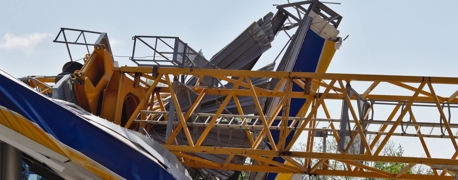Why Are So Many Workers Dying in New Mexico?

On August 23, 2022, 23-year-old welder David Warren reported for work at the El Segundo Coal Mine near Grants, New Mexico. Tragically, that day would be his last. While repairing a broken latch on a steel door weighing 26,000 pounds, the plastic stop used to block the door failed. Warren was crushed at the waist and later passed away while waiting for emergency life flight assistance. No 911 call was ever made, and emergency responders were initially given the wrong coordinates, delaying them from reaching the site in time.
A little more than a year later, 54-year-old New Mexico Highland University (NMHU) custodian Martin Lujan died after working at the facility’s Ivan Hilton Science and Technology Building. According to the University, the Ivan Hilton building was closed on September 3, 2023, due to concerns about chemical storage and maintenance. However, complaints about a powerful chemical smell had been made as far back as July 16th. An inspection on September 3rd uncovered a dimethylamine hydrochloride leak, as well as expired, unlabeled chemicals throughout the building. Lujan passed away on September 14, and a subsequent investigation into his death was opened.
These are not isolated tragedies. According to the Bureau of Labor Statistics (BLS), in 2022 alone, 57 workers in New Mexico lost their lives due to work-related incidents, averaging more than one fatality per week. That equates to a fatality rate of 7.6 per 100,000 workers—nearly double the national average of 4.2 deaths per every 100,000 workers.
The reasons behind this high occupational fatality rate are complex, but one fact remains clear: New Mexico’s workplaces are among the most dangerous in the country. From oilfields and highways to construction zones and industrial sites, workers face lethal risks every day. And while some jobs are inherently hazardous, no job is worth a life. These incidents are entirely preventable—the result of employers who cut corners, fail to enforce safety protocols, or put profits over people.
New Mexico’s Deadliest Industries
Workers in all roles across all industries face certain on-the-job hazards, but history shows that certain sectors have higher risks than others.
- Transportation: Year after year, transportation-related occupational deaths account for the majority of these tragedies. Data from the BLS reveal that transportation incidents made up 58% of all fatal workplace events in New Mexico in 2023. This includes transportation across a variety of industries, including trucking, construction, and warehousing.
- Transportation and Warehousing: In 2023, New Mexico’s transportation and warehousing sector experienced the highest number of worker fatalities, with a striking 11 of the 38 total deaths (29%) occurring in this area.
- Construction: Mirroring national statistics, New Mexico’s construction industry consistently sees high worker fatality rates. In 2023, the BLS reported five occupational fatalities in this sector, accounting for 13% of the state’s workplace deaths for that year.
- Mining, Quarrying, and Oil and Gas Extraction: New Mexico workers in the mining, quarrying, and oil and gas extraction industries are also statistically at a higher risk of suffering work-related injuries and fatalities. In 2023, this sector accounted for 13% of the state’s total occupational deaths.
Other dangerous sectors include manufacturing, specialty trade contracting, general freight trucking, and pipeline transportation. Below, we’ll take a closer look at some of these deadly industries.
Transportation
When we picture a workplace accident, we might think of a factory floor or a construction site. But for many New Mexico workers, the most dangerous part of the job is the drive itself.
In 2022, transportation incidents accounted for 31 of the state’s 57 fatal occupational injuries—more than half of all the work-related deaths that year. That includes workers killed while driving trucks, operating heavy equipment, or simply commuting between job sites. The state’s vast rural geography, poorly maintained roads, long distances between cities, and high-speed travel all contribute to a perfect storm of heightened risk for transportation workers.
- Trucking & Delivery: In 2022, New Mexico’s transportation and warehousing sector saw 17 worker fatalities, more than any other industry. Commercial truck drivers are especially vulnerable. With long hours, tight deadlines, and fatigue as constant companions, they face deadly hazards every day, from rollovers and jackknifes to rear-end collisions and crashes caused by poorly maintained equipment. Many of these drivers operate in the oilfields of southeastern New Mexico, where remote highways, like U.S. 285 (nicknamed “Death Highway”), are notorious for deadly wrecks.
- Oilfield Transport: Oil and gas companies often require workers to drive long distances, sometimes alone, in the dark, or after grueling shifts. This increases the risk of fatigue-related crashes, particularly in areas like the Permian Basin. In some cases, workers are ordered to haul equipment without proper training or drive unsafe vehicles that haven’t been inspected.
- Commuting Between Job Sites: In industries like construction, agriculture, and utility maintenance, workers often travel between multiple sites in a single day. If that travel is required by the employer, it’s considered part of the job, and any accident that occurs during that time counts as a work-related injury. Unfortunately, employers sometimes fail to provide safe transportation or allow workers to drive in dangerous weather conditions.
Whether it’s a long-haul truck or a short trip between job sites, employers are responsible for ensuring workers are protected on the road. That includes:
- Providing well-maintained vehicles
- Enforcing limits on shift length and drive time
- Training drivers in safety practices and company protocols
- Monitoring weather and road conditions
- Avoiding overloading or improper cargo handling
Too often, these safeguards are ignored or enforced only after tragedy strikes—and the consequences are devastating.
Oil & Gas Extraction
New Mexico is home to part of the Permian Basin, one of the most productive oil and gas regions in the world. But behind the billions in revenue and record-setting output lies a dangerous reality: the oil patch—and the oil and gas extraction industry in general—is one of the deadliest places to work.
Oil and gas work involves intense physical labor in extreme conditions. Workers often deal with flammable chemicals, high-pressure lines, heavy equipment, and constant exposure to environmental hazards. What makes it even more dangerous is that it all takes place in remote areas, far from immediate medical assistance if something goes wrong.
And things do go wrong—often.
Blowouts, flash fires, toxic gas releases, explosions, and crushing injuries are tragically common. Much like in construction, these incidents are frequently traced back to lax safety protocols, insufficient training, understaffing, or failure to properly maintain equipment.
Beyond the physical risks posed by explosions and equipment, oil and gas workers are also exposed to harmful substances like benzene, methane, and hydrogen sulfide (H₂S). Even brief exposure to high concentrations of H₂S can be fatal. This invisible killer is often present near drilling sites, and workers who aren’t equipped with functioning gas detectors or protective breathing gear may have no warning until it’s too late.
Construction
Construction is the backbone of New Mexico’s growth. From expanding highways and bridges to building homes and commercial centers, construction workers are responsible for shaping the physical landscape of the state. But behind every development project lies a workforce exposed to one of the most dangerous jobs in the country. In 2023, New Mexico reported five construction-related fatalities. These deaths were not only devastating but, in many cases, preventable.
Construction sites are inherently hazardous. Workers operate heavy equipment, climb to great heights, navigate uneven surfaces, and work near power lines and unstable structures. But when safety measures are cut or ignored, what should be a high-risk but manageable environment becomes a death trap.
Many of New Mexico’s fatal construction accidents involve:
- Falls from heights, whether from scaffolding, roofs, ladders, or framing structures.
- Struck-by incidents, where workers are hit by moving vehicles, falling tools, or collapsing materials.
- Electrocution, often due to contact with overhead lines or faulty wiring in active build zones.
- Trench collapses, sometimes burying workers alive when proper shoring or protective systems are not in place.
One of the most pressing issues in construction is the race to meet tight project deadlines, often at the expense of worker safety. Contractors under pressure may skip hazard assessments, delay maintenance, or fail to train workers thoroughly on proper procedures and equipment use.
These shortcuts can cost lives, especially for younger, less experienced workers who may not yet recognize unsafe conditions or feel empowered to speak up.
Mining, Quarrying & Natural Resource Extraction
Beneath New Mexico’s desert floor lies a wealth of natural resources—coal, potash, copper, and rare earth minerals. Thousands of workers make their living extracting these materials from the earth. But mining, quarrying, and other forms of natural resource extraction remain among the most hazardous industries in the state.
The dangers in mining, quarrying, and natural resource extraction are varied and unforgiving. Workers may face:
- Cave-ins or rockfalls, especially in operations where ground stability assessments are outdated or incomplete.
- Explosions from methane gas pockets or chemical interactions.
- Crushing injuries from massive vehicles or conveyor belts that allow little room for error.
- Exposure to toxic substances, such as silica dust, diesel fumes, or hazardous chemicals used in processing.
These environments often lack sufficient medical response capabilities due to their remote locations, meaning that even survivable injuries can become fatal without immediate help.
Who Is Most at Risk?
Statistically, some workers are at a higher risk of being exposed to workplace hazards that may lead to catastrophic injury or death.
Men
In 2022, men made up the vast majority (93%) of workplace fatalities in New Mexico. The same was true in 2023, where 89% of the state’s workplace fatalities were men. This reflects national statistics, and the reasons are multifaceted.
Men dominate high-risk sectors, such as transportation, construction, and oil and gas extraction. These industries involve physical labor, heavy machinery, and hazardous conditions, all contributing to the high death toll. But it’s also a reflection of a deeper issue: There is a marked gender divide in occupational safety culture, where men are often expected to perform the most physically demanding and dangerous jobs with fewer protective measures in place.
30- to 50-Year-Olds
Age is another significant factor in workplace fatalities in New Mexico. While the fatality rate doesn’t discriminate entirely based on age, certain age groups are disproportionately affected by workplace hazards, with workers in their late 30s to early 50s being statistically the most at risk. This period often coincides with years of experience but also with increasing physical wear and tear from long hours, hazardous tasks, and repetitive motions.
Workers who are 55 and older face even higher risks due to physical limitations that can make it harder to react in emergencies or endure the physically demanding work environments typical in New Mexico’s high-risk industries.
Hispanics & Latinos
According to the BLS, Hispanic and Latino workers accounted for 13 occupational fatalities in New Mexico in 2023, representing 34% of the state's total work-related deaths that year. The overrepresentation of Hispanic and Latino workers involved in fatal workplace incidents is likely influenced by several factors.
In 2023, people who self-identified as Hispanic or Latino represented 62.4% of New Mexico's workforce, a higher proportion than the state's overall population (58.6%). With more workers of Hispanic or Latino heritage in the workforce, it follows that this group would also make up a significant portion of the state’s occupational injuries and fatalities.
Hispanic and Latino workers also make up a significant portion of workers in high-risk industries, such as construction, agriculture, and oil and gas extraction. These sectors are characterized by physical labor, heavy machinery, and hazardous conditions, increasing the likelihood of fatal accidents.
While certain groups statistically face a higher risk of being hurt on the job in New Mexico, the real issue is the widespread and systemic negligence by employers that continues to put all employees at risk.
When Negligence Turns Risk into Tragedy: Uncovering the Real Cause of Workplace Injuries & Deaths in New Mexico
Behind every workplace fatality lies a simple truth: none of these deaths had to happen. While oil rigs, mines, construction sites, and highways come with built-in hazards, it’s the failure to control those hazards that makes them deadly. Whether it’s a fall from scaffolding, exposure to toxic chemicals, or a collision on a remote oilfield road, the common thread running through New Mexico’s fatal incidents is not the work itself but how the work is managed.
Behind every common type of workplace incident is a series of decisions—to cut corners, to ignore safety standards, to skip employee training. Though they’re often made to cut costs, these decisions typically come at the highest price: workers’ lives.
Equipment & Machinery Incidents
Many of New Mexico’s workplace fatalities result from contact with equipment or machinery. This can lead to crushing injuries, amputations, and blunt force trauma.
These tragedies often occur when employers fail to maintain the very machines their workers rely on. When companies fail to maintain equipment or cut corners on safety protocols, heavy machinery goes from an essential element of the job to a loaded weapon.
Toxic Exposure
In oilfields, chemical plants, or enclosed spaces, invisible dangers can quickly turn deadly. Hydrogen sulfide (H₂S), a gas common in oil and gas extraction, is one of the most dangerous substances to which workers are routinely exposed. At high concentrations, H₂S can kill in seconds.
Many workers aren’t properly trained to recognize the signs of toxic exposure, and, too often, employers fail to provide functioning gas monitors or adequate ventilation. In remote locations, even those who survive initial exposure may die before help arrives.
Falls
Falls—from heights or slip and fall accidents—are among the most common workplace incidents nationwide. Worse, they are entirely preventable. Guardrails, harnesses, safety nets, and fall arrest systems save lives when used properly. But in the field, workers are still sent up scaffolding without harnesses or tasked with fixing roofs alone without anchor points or spotters.
Employers have a strict responsibility to protect workers from fall hazards. When they fail, the consequences are often catastrophic—and it’s workers and their families who pay the ultimate price.
Violence
Ten workplace deaths in New Mexico in 2022 were due to violence or attacks—most of them involving people, not animals. These incidents can stem from domestic disputes that spill into the workplace, confrontations between coworkers, or even assaults during robberies or remote shifts.
The common factor? A lack of preparedness. Too many employers don’t train workers on de-escalation or fail to implement any kind of violence prevention protocols. In isolated or understaffed workplaces, workers can be left without a way to call for help or even notify someone that an incident is happening.
At the heart of each of these categories lies one cause: negligence. When employers refuse to follow safety laws, skimp on equipment maintenance, or prioritize productivity over training, the workplace becomes a trap. The workers who suffer the consequences rarely have the power to change these conditions on their own.
That’s why accountability matters.
When Lives Are on the Line, the Law Demands Accountability
New Mexico’s workers aren’t dying because their jobs are inherently dangerous. They’re dying because too many employers are willing to gamble with lives to cut costs or speed up production. Whether it’s skipping a safety inspection, rushing a new hire onto a jobsite without proper training, or failing to repair a known equipment issue, these choices have real, life-altering consequences.
In a state where the workplace fatality rate is nearly double the national average, it’s time to stop treating these deaths as inevitable. They are not. They are the result of many decisions—decisions made in boardrooms, management offices, and site trailers. Decisions that prioritize output over safety. Decisions that can, and must, be changed.
Accountability means more than just issuing a press release after a tragedy or paying a fine months later. It means putting people first—always.
To keep workers safe, employers must:
- Enforce rigorous training protocols before workers are exposed to danger.
- Perform regular maintenance and inspections on vehicles, equipment, and protective gear.
- Empower workers to report unsafe conditions without fear of retaliation.
- Follow OSHA standards, not as minimums, but as baselines to exceed.
Workers in New Mexico—and across the country—deserve more than sympathy after a tragedy. They deserve action before a tragedy occurs.
At Arnold & Itkin, we’ve stood with the families of workers who were killed simply for doing their jobs. We’ve seen the devastation that follows a phone call no family should ever get. And we’ve held negligent employers accountable, because when companies refuse to protect their people, they must answer for it.
No one should have to trade their life for a paycheck. Not in New Mexico. Not anywhere.
- Categories


